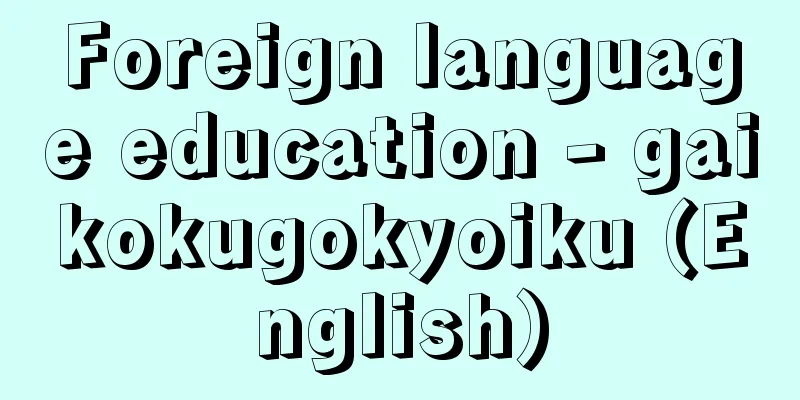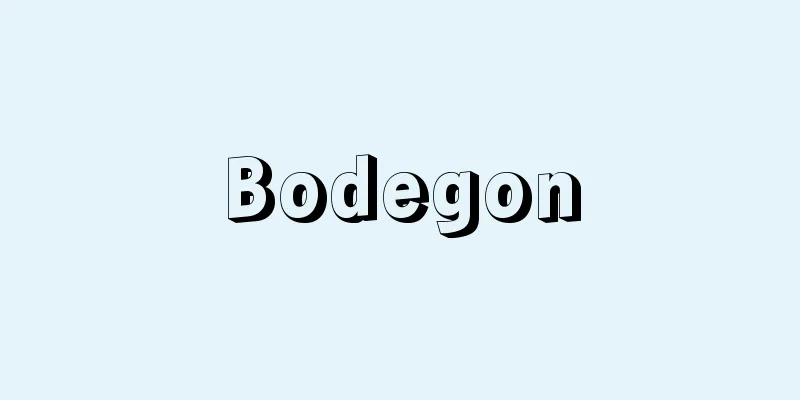Foreign language education - gaikokugokyoiku (English)

|
A foreign language is a language that is not used as a means of daily communication in the community to which the learner belongs. On the other hand, a second language is a language that is a common means of communication in a community composed of people who use different languages. However, in response to the progress of internationalization and from the perspective of cultivating the qualities necessary to live in an international community, the goal of foreign language education is to learn a foreign language that is a common language in the international community as a second language, that is, a common means of communication, and to develop not only comprehension but also the ability to express. Taking the foreign language section of the junior high school curriculum guidelines revised in 2008 as an example, the three goals are to deepen understanding of language and culture through a foreign language, to foster an attitude of actively trying to communicate, and to cultivate the basics of communication skills such as listening, speaking, reading, and writing. Rather than merely acquiring knowledge such as grammar and vocabulary, students are expected to acquire the four skills of listening, speaking, reading, and writing in a balanced manner as the basic abilities to communicate in a foreign language. [Methods of foreign language education] Foreign language teaching methods can be roughly divided into three categories. One is the traditional teaching method, the grammar translation method, which mainly uses grammar explanations and textbook translation. This is a traditional teaching method that relies on textbooks and aims to enable accurate translation as a means of absorbing foreign culture. With this method, instruction is provided with the aim of enabling students to control grammar as a normative rule and to memorize a large number of vocabulary words. Grammar translation method is often used in high school classes that focus on reading comprehension. With grammar translation method, direct instruction in communication in the foreign language is not provided, and instead the emphasis is placed on developing grammar knowledge and vocabulary skills as the basic abilities required for communicating in a foreign language in the future. The second is the audio-lingual method, which has the primary goal of cultivating listening and speaking abilities and emphasizes oral practice of listening and sentence patterns. It is a teaching method devised as a technique to directly cultivate listening and speaking abilities as a criticism of the grammar translation method. Behind this method is a language acquisition theory based on structural linguistic analysis of foreign languages and behavioral learning theory. Behaviorist learning theory holds that foreign languages are also acquired by forming habits through repeated practice. For this reason, practice is emphasized. Practice is carried out using materials that are carefully arranged from simple sentence patterns to gradually more complex sentence patterns based on structural linguistic analysis. A typical lesson begins with an introduction to the basic dialogue of the lesson, followed by an explanation of new grammar points and new words, followed by an explanation of new sentence patterns, sentence pattern practice (such as pattern practice by word replacement), supplementary practice, and memorization of the dialogue. Because this method is based on the idea that a foreign language is acquired through the formation of habits, pronunciation and grammatical errors are strictly corrected to prevent the formation of bad habits, and accurate pronunciation and grammatically correct speech are always required. This method does not train the skills necessary for actual communication, such as in what situations the acquired sentence patterns can be used, or what to do if the conversation does not proceed according to the memorized dialogue. In addition, because it is based on a behaviorist learning theory, learners tend to be passive beings who are trained by teachers. The third is the communicative approach, which mainly involves students in proactively communicating in the classroom. This method is sometimes called communicative language teaching (CLT). Its purpose is to develop communication skills in a foreign language. The definition of communicative competence by Canale, M. and Swain, M. (1980) is well known as the ability required for effective communication in a foreign language. In other words, communicative competence is composed of four sub-abilities: grammatical ability to use vocabulary, grammar, sounds, and letters; discourse ability to understand and construct coherent sentences and conversations; sociolinguistic ability to determine whether the sentences used are general expressions appropriate to the situation; and strategic ability to use strategies to facilitate smooth communication. The communicative approach is based on the idea that it is effective to have students actively engage in language activities in a foreign language in the classroom in order to acquire such communicative competence. To achieve this, tasks are used that require students to communicate in a foreign language during class, gather information, and solve problems. In communicative approach classes, students are not expected to memorize words or practice sentence patterns, but to complete tasks. Therefore, if the tasks are in response to students' interests and concerns, high levels of intrinsic motivation can be expected. However, there is criticism that this approach is not suitable for acquiring systematic and accurate grammar knowledge or pronunciation. [Foreign Language Education Classes] In foreign language education, which aims to develop communication skills, a change is required from classes that mainly use grammar explanations and sentence pattern practice to classes that emphasize active language activities. In actual classes, it is important to be able to select an appropriate method according to the specific educational goals and the characteristics of the target learners. When the learner is an adult, there are disadvantages such as difficulty in learning due to interference from the mother tongue that the learner has already acquired and anxiety about learning a foreign language. However, on the other hand, there are advantages in that general learning skills that depend on developed intellectual abilities, systematic teaching materials, and linguistic rules can be used. On the other hand, in the case of child learners, while there is an advantage over adults in that there is less interference from the mother tongue and anxiety associated with learning, they have not yet fully acquired the general learning abilities that adults can use, and it is difficult to learn using linguistic rules, so it is said that it is difficult for them to learn a foreign language in the same way as adults. Therefore, when teaching a foreign language at the elementary school level, it is necessary to make use of the characteristics of the child rather than bringing forward the content to be taught at the junior high school level. In foreign language education for children, it is effective to prioritize auditory comprehension over speaking, and to use techniques that encourage students to use their entire body to express what they have heard and understood, or to provide language activities in the form of games. In addition, when language activities are carried out in the classroom, it is also important for the teacher to create an atmosphere in the classroom where students can freely express their thoughts and opinions in front of others without feeling threatened by their ego, whether in a foreign language or their native language. → Second language acquisition → Bilingualism → Bilingual education [Kazumi Nakajo] Latest Sources Psychology Encyclopedia Latest Psychology Encyclopedia About Information |
|
外国語とは,学習者が属するコミュニティで日常のコミュニケーションの手段として使用されることのない言語を指す。一方,第2言語second languageとは,異なる言語を用いる人びとで構成されるコミュニティにおいて共通のコミュニケーション手段とされる言語である。しかし,国際化の進展に対応し,国際社会の中に生きるために必要な資質を養うという視点に立てば,国際社会で共通語とされる外国語を第2言語,すなわち共通のコミュニケーション手段として学習し,理解力ばかりでなく発信力を育成することが外国語教育の目標となる。2008年に改訂された中学校学習指導要領の外国語科を例に取れば,外国語を通じて,言語や文化に対する理解を深めること,積極的にコミュニケーションを図ろうとする態度の育成を図ること,聞く,話す,読む,書くなどのコミュニケーション能力の基礎を養うことの3点が目標とされる。文法や語彙などの知識の習得にとどまることなく,外国語でコミュニケーションできるための基礎となる能力として,聞く,話す,読む,書くという四つの技能をバランス良く獲得することが求められている。 【外国語教育の方法】 外国語の教授法は,おおむね三つの系統に区分されるだろう。一つは,伝統的な教授法であり,文法の解説と教科書の訳読を主たる技法とする文法訳読法grammar translation methodである。教科書に依存する伝統的な教授法であり,外国文化を吸収する手だてとして正確な訳読ができることを目的とする。この方法では,規範的な規則としての文法を操れること,単語をたくさん記憶していることをめざした指導が行なわれる。高等学校の読解を中心とした授業などでは文法訳読法が多く用いられている。文法訳読法では,外国語によるコミュニケーションの直接的な指導は行なわれず,将来において外国語を用いてコミュニケーションをする際の基盤となる能力として,文法の知識や語彙力の育成に力点がおかれている。 二つ目は,「聞く」「話す」能力の育成を第1の目的として,聞き取りや文型の口頭練習を重視するオーディオリンガル法audio-lingual methodである。文法訳読法への批判として,「聞く」「話す」能力を直接的に育成する技法として考案された教授法である。この方法の背景には,構造言語学による外国語の分析と行動主義的学習理論の立場に立つ言語習得理論がある。行動主義の学習理論では,外国語もまた繰り返し練習による習慣形成によって習得されると考えている。そのために練習が重視される。練習は,構造言語学による分析に基づいて単純な文型から徐々に複雑な文型へと緻密に配置された教材に沿って行なわれる。典型的な授業は,その課の基本対話の導入に始まり,新出の文法事項や新出の単語の説明,それに続く新しい文型の説明,文型練習(単語の置き換えによるパターン練習など),補充練習,対話文の暗記が行なわれる。外国語は習慣形成によって習得されるという考え方を背景としているために,誤った習慣が形成されないように,発音や文法の誤りなどは厳しく修正され,つねに,正確な発音と文法的に正しい発話が求められる。この方法では,習得した文型がどのような場面で使用できるのか,暗記した対話どおりに会話が進まない場合にはどうしたらよいのかといった,実際のコミュニケーションに必要な能力が訓練されることはない。また,行動主義的な学習理論に立脚しているために,学習者は教師によって訓練される受動的存在となりがちである。 三つ目は,教室で学習者に主体的なコミュニケーションを行なわせることを主たる技法とするコミュニカティブ・アプローチcommunicative approachである。この方法は,コミュニカティブ・ランゲージ・ティーチングcommunicative language teaching(CLT)とよばれることもある。外国語によるコミュニケーション能力そのものを育成することが目的とされる。外国語を用いて有効なコミュニケーションを行なううえで必要な能力として,カナールCanale,M.とスウェインSwain,M.(1980)のコミュニケーション能力の定義がよく知られている。すなわち,コミュニケーション能力communicative competenceは,語彙や文法,音声,文字を使いこなすための文法能力,まとまりのある文章や会話を理解したり,構成したりするための談話能力,使用する文がその場にふさわしい一般的な表現であるかどうかを判断するための社会言語学的能力,コミュニケーションを円滑に進めるための方略を利用できる方略能力という四つの下位能力で構成されているという説である。このようなコミュニケーション能力の習得のために,教室で外国語を用いた主体的な言語活動を行なわせることが有効であるとするのが,コミュニカティブ・アプローチである。そのために,授業中に外国語を用いてコミュニケーションし,情報収集したり課題を解決したりするタスクが用いられる。コミュニカティブ・アプローチの授業で学習者に求められるのは,単語の記憶でも文型練習でもなくタスクの遂行である。したがって,タスクが学習者の興味や関心に即応している場合には高い内発的動機づけを期待できる。しかし,体系立った正確な文法知識の習得や正確な発音の習得には向かないといった批判もある。 【外国語教育の授業】 コミュニケーション能力の育成を目標とする外国語教育では,文法解説や文型練習を主たる技法とする授業から能動的な言語活動を重視した授業への変化が求められている。実際の授業では,具体的な教育目標や対象となる学習者の特性に応じて適切な方法を選択できることが重要となる。学習者が成人の場合は,すでに身につけている母語からの干渉のために学習がむずかしくなることや外国語学習に対する不安など不利な点をもつ。しかし,その一方で,発達した知的能力に依存する一般的な学習技能や,体系づけられた教材や言語学的な規則が利用できるという利点をもっている。一方,児童期の学習者の場合には,母語からの干渉や学習に伴う不安が少ないという点で成人の場合より有利である一方で,成人の場合に利用できるような一般的学習能力が十分に獲得されておらず,言語学的な規則を利用した学習も難しいことから,成人と同じ方法で外国語を習得することは困難であるとされている。そのため,小学校段階で外国語教育を行なう場合には,中学校段階で教える内容を前倒しするのではなく,児童期の特性を生かす必要がある。児童期の外国語教育では,発話よりも聴覚的理解を優先し,聞いて理解した事柄を体全体で表現させるような技法を用いたり,言語活動をゲームとして与えたりするなどの工夫も有効である。 また,教室で言語活動を行なう場合,外国語であろうと母国語であろうと,他者を前にして自分の考えや意見を自由に述べても自我が脅威にさらされることのない,自己を表現しやすい教室の雰囲気を作ることも教師の役割として重要となる。 →第2言語習得 →バイリンガリズム →バイリンガル教育 〔中條 和光〕 出典 最新 心理学事典最新 心理学事典について 情報 |
<<: Travel notes - Kaikoku Zakki
>>: The origin of opening up the country
Recommend
Cirta (English spelling)
The capital of Numidia in ancient North Africa. To...
Asthenosoma ijimai (English spelling)
…Generally, there is a thin poisonous spine on th...
Side effect - Fukusayo (English spelling)
This refers to effects that occur when a medical p...
Osami Nagano
A naval officer during the Taisho and Showa perio...
Kidoike [Hot Spring] - Kidoike
...The town occupies the Yomase River basin, a tr...
alcaicería (English spelling) alcaiceria
…There have been various theories about the origi...
Basic morphology
…In biology, this concept is used to organize and...
The Dengaku Daigakushi (English: Dian-ge Da-xue-shi; Tien-ko Ta-hsüeh-shih)
An official title in China from the Song dynasty t...
Distance learning - tsuushinkyoiku
Correspondence education refers to a form of educ...
Systems analysis
It is a method of determining the most appropriate...
Freesia armstrongii (English spelling)
…[Tora Saburo Kawabata]. … *Some of the terminolo...
Saijo [city] - Saijo
A city located in the northeastern part of Ehime P...
Catholic Reformation
A movement for self-reform and reform unique to th...
Gold crown (tooth) - kumquat
...However, the term "dentures" general...
Administration of justice
It involves the establishment and management of t...









